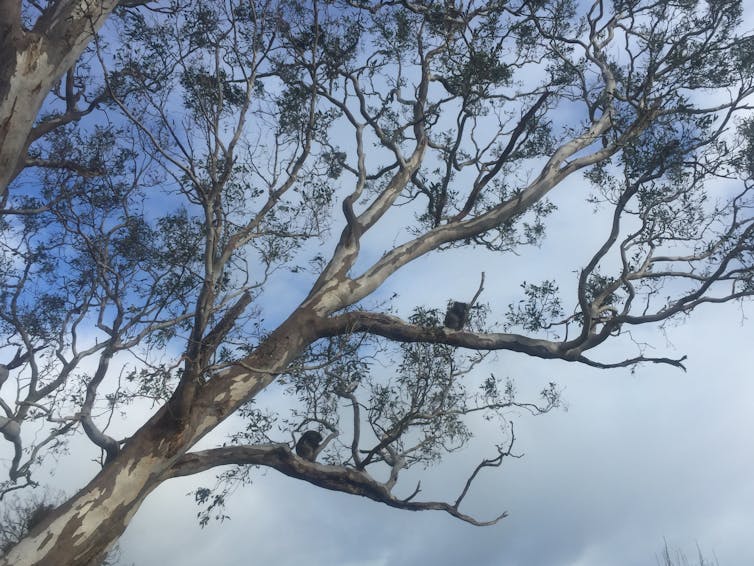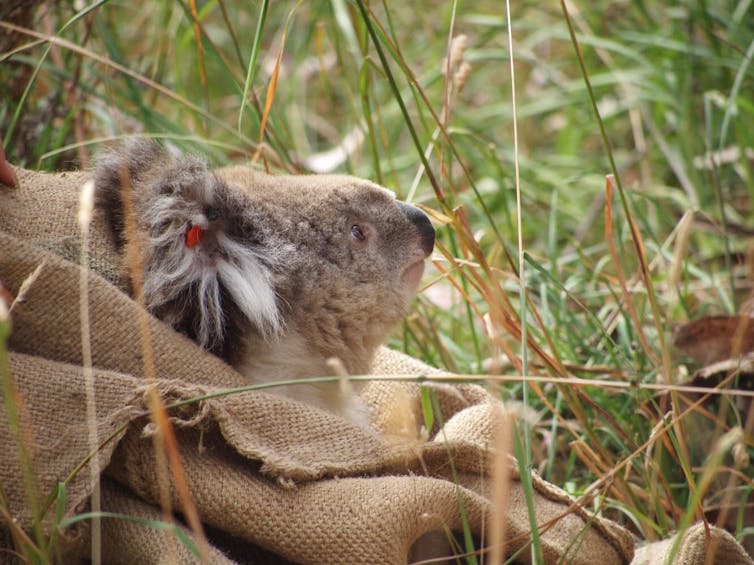The Blinky Bill effect: when gum trees are cut down, where do the koalas go?
GUEST OBSERVATION
In the past two decades there has been an unprecedented increase in the area of blue gum (Eucalyptus globulus) plantations in southern Australia.
In southwest Victoria alone, some additional 80,000 hectares of commercial blue gum have been planted.
This expansion has significantly increased the habitat available for koalas. In fact, my research, published in the journal Landscape and Urban Planning, has found there are more koalas in plantations than in surrounding native habitat.
More koalas may seem like a good thing, but perversely this could ultimately harm their welfare (and the welfare of other native animals and plants), and disrupt the plantation industry.
Plantations
Koalas are protected in Victoria, so when plantation managers harvest the mature trees they must have a permit and a koala management plan. These plans focus on locating koalas, ensuring that the trees koalas are sitting in at harvest are not felled, and post-harvest surveys to find any injured koalas.
However, these plans don’t consider where the koalas go after the plantation has been cut down, and what effects their movement has on the landscape and surrounding native vegetation.
A recently harvested blue gum plantation showing remnant trees left due to koalas. Author provided
To work out how factors such as plantation cover affect koala populations, my colleagues and I surveyed 72 sites across southwest Victoria. We found more koalas in plantations than in blocks of native vegetation or in native roadside vegetation.
We then spatially modelled koala numbers for the region, and found several high-priority areas for population management, as well as significant conservation habitat for koalas and other wildlife in the region that overlap with high koala population densities.
Our mapping predicted high koala numbers in the southeast, where there are important remnant bushland areas such as Kurtonitj Indigenous Protected Area and Mount Napier State Park. This highlights the importance of considering the overall landscape when establishing and harvesting plantations, and the arrangement of plantations near remnant forest.
Harvest rates in much of southwest Victoria are set to increase. This may result in increased koala numbers in the native vegetation surrounding harvested sites, which could then put pressure on food trees in remnant forests.
Local landholders are already seeing the effect of more koalas on native vegetation. Many trees on private land or beside roads are being stripped of leaves.
Canopy defoliation of remnant trees due to increased numbers of koalas in south-west Victoria. Author provided
More koalas are also likely to mean more injuries or other welfare issues. As plantations have a responsibility to avoid these, koala injuries could threaten the future of one of the main industries in this region. More than 4,000 people are directly employed in the regional forestry industry, with a further 4,500 in associated service industries.
The bigger picture
To meet this challenge, we argue management plans need to consider the larger landscape. What native forest is near a plantation? Where are the koalas likely to go after the harvest? How might they affect other native species?
A female koala being released in Bessiebelle, south-west Victoria, after undergoing a health check. Esther Wong, Author provided
Such plans could include some areas of plantations set aside for koala habitat, harvesting plans that consider adjacent habitat that koalas may move into, or increasing areas of native food trees. These would all benefit other wildlife in the area, as well as koalas.
Currently, there is something of a negative feedback loop in southwest Victoria. When plantations are established koalas move in and reproduce. When plantations are later harvested, the koalas move into surrounding areas. As a result, populations can rapidly increase in some areas, affecting native trees and creating welfare issues for the forest industry.
We have seen the devastating effects high density koala populations can have on native forests in places like Cape Otway, which saw mass starvation and widespread forest death in 2013 and 2014. Current state regulations could disrupt the forestry industry, especially with koala numbers increasing in plantations but with no plan to really manage koala numbers in southwest Victoria in sight.![]()
Kita Ashman, PhD candidate in koala conservation, Deakin University.
This article is republished from The Conversation under a Creative Commons license. Read the original article.



